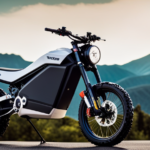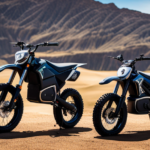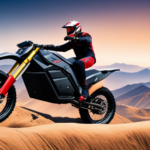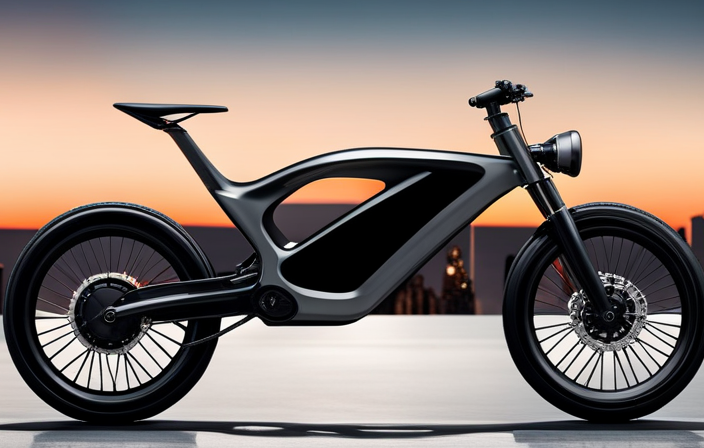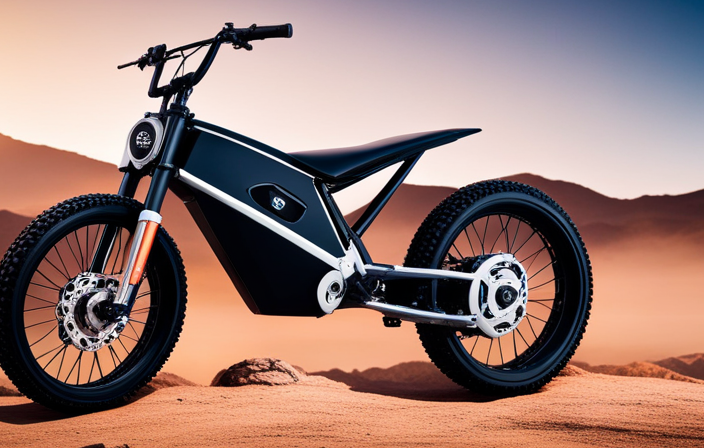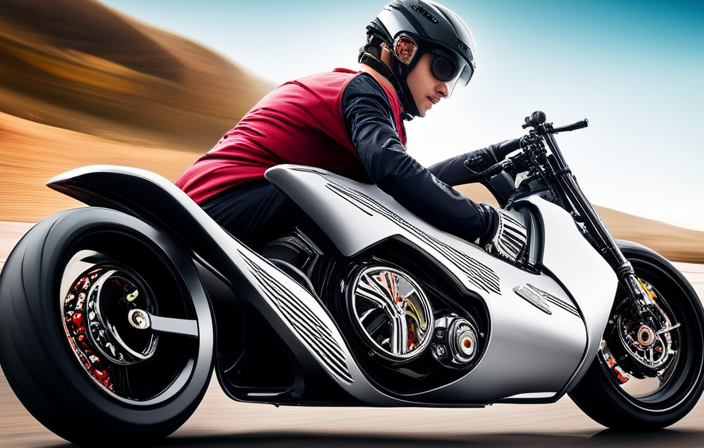I have always wondered about the price of a KTM electric dirt bike. It is a favorite among off-road enthusiasts, and I have heard rave reviews about its performance and durability.
In this article, we’ll dive into the different models available, the price range, and any additional costs to consider. I’ll also share some benefits of owning a KTM electric dirt bike and provide information on financing options and where to buy one.
Let’s get started and find out the truth behind the price of these impressive machines.
Key Takeaways
- KTM electric dirt bikes have a range of options available, with impressive features and performance.
- The pricing for KTM electric dirt bikes varies depending on the model and features, with entry-level models starting at around $5,000 and higher-end models available for around $10,000.
- Additional costs to consider include accessories, charging infrastructure, and insurance coverage.
- Buying a used KTM electric dirt bike can be a cost-effective option, with a wider range of models and years to choose from.
KTM Electric Dirt Bike Models
If you’re interested in KTM electric dirt bike models, you’ll be pleased to know that they offer a range of options to choose from. KTM electric dirt bikes are known for their impressive features and exceptional performance. These bikes are designed to provide an exhilarating off-road experience while also being environmentally friendly.
The KTM electric dirt bike features include powerful electric motors, advanced suspension systems, and durable construction. They are built to handle the toughest terrains and deliver a thrilling ride. In terms of performance, KTM electric dirt bikes offer high acceleration and top speeds, ensuring that riders can tackle any challenge with ease.
With their cutting-edge technology and innovative design, KTM electric dirt bikes are a top choice for riders who seek both power and sustainability. Now, let’s explore the price range of KTM electric dirt bikes.
Price Range of KTM Electric Dirt Bikes
The price range for KTM’s electric off-road motorcycles varies depending on the model and features. KTM offers a range of options to suit different budgets and preferences. The entry-level model, the KTM SX-E 5, has a starting price of around $5,000. This bike is designed for younger riders and offers a great value option for those looking to get into electric dirt biking.
On the higher end, the KTM Freeride E-XC is available for around $10,000. This model is more powerful and equipped with advanced features suitable for experienced riders. It’s important to consider your needs and skill level when choosing the best value option for you.
Now, let’s move on to additional costs to consider when buying a KTM electric dirt bike.
Additional Costs to Consider
When considering purchasing a KTM electric dirt bike, it’s important to take into account the potential additional costs. In addition to the upfront price of the bike itself, there are expenses associated with accessories and charging infrastructure that you should be aware of.
Accessories costs can include things like protective gear, such as helmets and body armor, as well as optional extras like upgraded suspension or lights. These costs can add up, so it’s important to factor them into your budget.
Another important consideration is the charging infrastructure. While electric dirt bikes can be charged at home using a regular power outlet, you may also want to invest in a dedicated charging station for faster charging times. It’s worth researching the availability and cost of charging stations in your area.
Taking these additional costs into account will help you make an informed decision about purchasing a KTM electric dirt bike.
Transition: Now that we’ve discussed the potential additional costs, let’s explore the benefits of owning a KTM electric dirt bike.
Benefits of Owning a KTM Electric Dirt Bike
Owning a KTM electric dirt bike comes with a range of benefits that make it a worthwhile investment.
One of the key advantages of owning an electric dirt bike is the low maintenance requirements. Unlike traditional dirt bikes that require regular oil changes and tune-ups, electric dirt bikes have fewer moving parts and require less maintenance overall. This not only saves you time but also reduces the cost of ownership.
Additionally, electric dirt bikes have a significantly lower environmental impact compared to their gas-powered counterparts. With zero emissions and no fuel consumption, electric dirt bikes are much cleaner and contribute to a greener environment.
Now that we’ve explored the benefits of owning a KTM electric dirt bike, let’s delve into the financing options available.
Financing Options
Financing options for a KTM electric dirt bike are available to help you make your purchase more affordable. Whether you’re looking to buy or lease, there are various financing plans that can suit your needs. Many dealerships offer financing options with competitive interest rates and flexible repayment terms.
Leasing options are also available, allowing you to enjoy the benefits of owning a KTM electric dirt bike without the long-term commitment.
Additionally, it’s important to consider insurance coverage for your new bike. Most insurance providers offer policies specifically designed for electric dirt bikes, providing coverage for accidents, theft, and other unforeseen events.
By exploring financing and insurance options, you can ensure a smooth and worry-free ownership experience.
Now, let’s move on to the next section and discuss the advantages of buying used KTM electric dirt bikes.
Used KTM Electric Dirt Bikes
When it comes to buying a used KTM electric dirt bike, there are both pros and cons to consider.
On the positive side, buying used can save you money compared to purchasing a brand new bike. However, it’s important to be cautious and thorough when inspecting and testing a used bike to ensure that you’re getting a reliable and well-maintained machine.
Here are some tips and considerations to keep in mind when buying a used KTM electric dirt bike.
Pros and cons of buying used
The pros of buying a used KTM electric dirt bike are that it can be more affordable and already broken in. When considering the purchase of a used electric dirt bike, there are several factors to keep in mind. Here are three key points to consider:
-
Cost-effectiveness: Buying a used KTM electric dirt bike can save you money compared to purchasing a brand new one. This allows you to get a high-quality bike at a more affordable price.
-
Pre-conditioned: Used bikes have already been broken in, meaning that any initial issues or glitches may have already been resolved. This can save you time and effort in getting the bike up to optimal performance.
-
Variety of options: When buying used, you have a wider range of models and years to choose from. This allows you to find a bike that suits your specific needs and preferences.
Considering these factors, buying a used KTM electric dirt bike can be a smart choice for those looking to save money and find a bike that is already in good working condition.
Now, let’s delve into some tips for buying a used KTM electric dirt bike.
Tips for buying a used KTM electric dirt bike
Now let’s explore some helpful tips for purchasing a pre-owned KTM e-dirt bike. When buying a used electric dirt bike, it’s important to have an inspection checklist to ensure you’re getting a quality bike at a fair price. Here are some key points to consider:
| Inspection Checklist | Negotiating Price |
|---|---|
| – Battery health | – Research market value |
| – Motor condition | – Point out any flaws or issues |
| – Frame and suspension | – Use comparable listings as leverage |
| – Brakes and tires | – Be willing to walk away |
| – Electronics and controls | – Consider additional costs (upgrades, repairs) |
Considerations for inspecting and testing used bikes
To ensure you’re making a good purchase, don’t forget to thoroughly inspect and test the used bike before buying it. Here are some inspection tips and testing methods that can help you make an informed decision:
-
Visual Inspection: Look for any obvious signs of damage or wear, such as scratches, dents, or rust. Pay attention to the frame, wheels, and suspension components.
-
Mechanical Inspection: Check the brakes, chain, and sprockets for wear. Inspect the forks, shocks, and bearings for any leaks or play. Ensure that all the electrical components are in working order.
-
Test Ride: Take the bike for a test ride to assess its performance. Pay attention to the engine’s responsiveness, gear shifting, and braking. Test the suspension for smoothness and stability.
-
Documentation: Request any maintenance records or service history that the seller may have. This can give you an idea of how well the bike has been maintained.
Where to Buy a KTM Electric Dirt Bike
You can find KTM electric dirt bikes at various authorized dealerships. These dealerships are spread across the country, making it convenient for customers to find and purchase their desired KTM electric dirt bike.
To find a KTM electric dirt bike, you can start by visiting the KTM official website and using their dealer locator tool. This tool allows you to search for dealerships near your location.
Additionally, you can visit popular online marketplaces and classified websites that specialize in selling motorcycles and dirt bikes.
It is important to note that the pricing for KTM electric dirt bikes may vary depending on the model and dealership. Therefore, it is recommended to compare prices from different authorized dealerships to ensure you are getting the best deal.
Now, let’s move on to the next section, where we will explore customer reviews and testimonials of KTM electric dirt bikes.
Customer Reviews and Testimonials
There’s a wide range of customer reviews and testimonials available for KTM electric dirt bikes. When it comes to customer satisfaction, KTM electric dirt bikes receive positive feedback from riders of all skill levels.
Many customers praise the bikes for their impressive performance and power. Some riders even compare them favorably to traditional gasoline-powered dirt bikes, noting their smooth acceleration and quiet operation. The electric motors provide instant torque, allowing riders to tackle challenging terrains with ease.
Additionally, KTM electric dirt bikes are known for their durability and reliability, making them a popular choice among off-road enthusiasts. With their exceptional performance and satisfied customers, KTM electric dirt bikes are definitely worth considering.
Now, let’s move on to maintenance and care tips to keep your KTM electric dirt bike in top shape.
Maintenance and Care Tips
As an expert in electric dirt bikes, I’m here to provide you with essential maintenance and care tips to ensure the longevity and optimal performance of your KTM electric dirt bike.
First and foremost, let’s start with a regular maintenance checklist. This includes tasks such as inspecting the tires, checking the battery, and tightening any loose bolts.
Inspecting the tires is crucial for safety and performance. Make sure they’re properly inflated and free from any damage or wear. If you notice any issues, replace the tires promptly.
Checking the battery is essential for an electric bike. Ensure it’s fully charged and functioning correctly. If the battery is old or not holding a charge, consider replacing it.
Tightening any loose bolts is important to prevent any parts from coming loose during your ride. Check all the bolts and screws on your bike, including the handlebars, seat, and footpegs.
In addition to regular maintenance, proper cleaning and storage are also vital. After each ride, clean your bike thoroughly to remove dirt, mud, and debris. This helps prevent corrosion and keeps your bike looking good.
When storing your electric dirt bike, make sure it’s in a dry and secure location. Avoid exposing it to extreme temperatures or moisture, as this can damage the components.
Lastly, let’s address common issues that riders may encounter. If you experience any problems, such as loss of power or strange noises, consult your bike’s manual or contact a qualified technician for assistance.
Regular maintenance checklist
Make sure you’re following a regular maintenance checklist for your KTM electric dirt bike. Keeping up with a regular maintenance schedule is crucial to keep your bike in optimal condition and extend its lifespan.
Here are some common maintenance mistakes to avoid:
-
Neglecting oil changes: Regularly changing the oil is essential for proper lubrication and to prevent engine damage.
-
Skipping air filter cleaning: A dirty air filter can restrict airflow and lead to poor performance. Clean or replace it regularly.
-
Ignoring chain maintenance: A well-lubricated and properly tensioned chain is crucial for smooth operation. Clean and lubricate it regularly.
-
Neglecting battery maintenance: Check the battery regularly, ensuring proper charging and storage to avoid battery failure.
By following these regular maintenance practices, you can ensure that your KTM electric dirt bike performs at its best.
Now, let’s move on to cleaning and storage recommendations for your bike.
Cleaning and storage recommendations
To properly clean and store your KTM electric dirt bike, it’s important to follow these recommendations.
When it comes to cleaning techniques, start by using a mild detergent and warm water to gently wash the bike’s exterior. Avoid using high-pressure washers as they can damage sensitive electrical components. Take extra care when cleaning the battery and charging port, using a damp cloth to wipe away any dirt or debris.
As for storage options, it’s best to keep your electric dirt bike in a cool and dry place, away from direct sunlight and extreme temperatures. Consider investing in a bike cover to protect it from dust and moisture.
Now, let’s move on to troubleshooting common issues with your KTM electric dirt bike…
Troubleshooting common issues
When troubleshooting common issues with your KTM electric dirt bike, it’s important to check the battery connections first. Common electrical issues can often be resolved by simply ensuring that the battery is properly connected. If you’re experiencing any problems with your bike, such as a lack of power or intermittent electrical failures, checking the battery connections should be your first step.
To help you understand the common troubleshooting techniques for your KTM electric dirt bike, I’ve created a table below. This table outlines the most common electrical issues and the corresponding solutions:
| Common Issue | Troubleshooting Technique |
|---|---|
| Lack of power | Check battery connections |
| Intermittent failures | Inspect wiring for any damage |
| Faulty lights | Replace bulbs or check wiring |
Conclusion and Final Thoughts
Overall, I’m really impressed with the performance and capabilities of the KTM electric dirt bike. It offers a thrilling riding experience with its powerful electric motor and responsive handling.
When it comes to financing options, KTM provides flexibility to make owning one of their electric dirt bikes more accessible. They offer various financing plans that cater to different budgets and needs. This allows customers to choose a payment plan that works best for them.
In terms of customer satisfaction, KTM has a strong reputation for delivering high-quality products and excellent customer service. Many riders have expressed their satisfaction with the KTM electric dirt bike, praising its reliability and performance.
Overall, the KTM electric dirt bike is a great option for riders who are looking for an electric off-road experience and want flexible financing options.
Frequently Asked Questions
How fast can a KTM electric dirt bike go?
A KTM electric dirt bike can reach impressive top speeds and has quick acceleration. The exact top speed may vary depending on the specific model, but they are known for their speed and performance on the dirt track.
What is the average battery life of a KTM electric dirt bike?
The average battery life of a KTM electric dirt bike varies depending on the model, but it typically ranges from 1 to 3 hours. Charging time can take anywhere from 1 to 4 hours.
Are there any government incentives or rebates available for purchasing a KTM electric dirt bike?
Well, let me tell you, the government is just throwing money at people who want to buy electric dirt bikes! There are plenty of incentives and rebates available for purchasing a KTM electric dirt bike. It’s a win-win situation!
Can a KTM electric dirt bike be charged using a regular household outlet?
Yes, a KTM electric dirt bike can be charged using a regular household outlet. This is one of the convenient charging options for electric dirt bikes, and it adds to the benefits of owning an electric dirt bike.
What is the warranty coverage for a KTM electric dirt bike?
The warranty coverage for a KTM electric dirt bike is quite impressive, offering peace of mind for any potential issues. Additionally, KTM provides extended warranty options for those who want even more protection.
Conclusion
After exploring the world of KTM electric dirt bikes, it is clear that they offer a thrilling and eco-friendly off-road experience.
With a range of models available, there is a KTM electric dirt bike to suit every rider’s needs and preferences.
While the prices may vary depending on the model and additional features, the benefits of owning a KTM electric dirt bike are undeniable.
From lower maintenance costs to reduced environmental impact, these bikes provide a unique and exciting way to enjoy the great outdoors.
So, if you’re ready to take your off-road adventures to the next level, consider investing in a KTM electric dirt bike.



